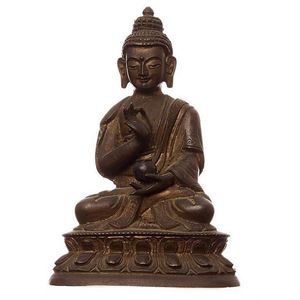Mandalay Monks: Carved Pair from Burma
You must be a subscriber, and be logged in to view price and dealer details.
Subscribe Now to view actual auction price for this item
When you subscribe, you have the option of setting the currency in which to display prices to $Au, $US, $NZ or Stg.
- Finial - An architectural decoration, found on the upper parts of of an object. On furniture they are usually found on pediments, canopies and shelf supports. On smaller ceramic or silver items, such as spoons, they may decorate the top of the item itself, or the lid or cover where they provide a useful handle for removal.
Finials have a variety of shapes and forms. They may be urn-shaped, baluster shaped round or spiral, but usually taper into an upper point. Many real life shapes may also be used as finials, such as pineapples, berries, pinecones, buds, lotus and acorns. Sometimes animals such as a lion are depicted, or fish and dolphins. - Patination / Patina - In broad terms, patination refers to the exterior surface appearance of the timber, the effect of fading caused by exposure to sunlight and air over the course of a century or more, changing the piece to a soft, mellow colour.
As patina is very difficult to replicate, it is one of the most important guides to determining the age of furniture.
Patina is also the term applied to the bloom or film found on old bronzes due to oxidisation. - Rustic - Rustic is defined as "of, relating to, or typical of country life or country people", and the items illustrated in this price guide accord with that definition.
But in the 18th and 19th century "rustic furniture" had a narrower definition. It referred to furniture where the framework was carved or moulded to resemble tree trunks and branches, and was usually for outdoor use. Rustic furniture was made in cast iron, wood, terracootta and concrete. Much of the Coalbrookdale company's cast iron furniture was of rustic design.
Visually similar items

A Late-14th Century/Early 15th century Tibetan bronze Buddha, height 22 cm, width 15 cm

Early Chinese carved wood deity figure. Temple figure of Daoist deity. On stand, probably 19th century.crack to figure & some worm damage. Provenance: Australian collector. Height 29 cm (figure only)

A large Thai gilt wood and jewelled seated Buddha, 64 cm high.

A bronze statue of Maitreya, modelled with a high bun, convex eyebrow mole, solemn expression, sitting on a double lotus pedestal, with left hand holding a bowl and right hand showing a Sharanagamana-Mudra, 10 cm high
